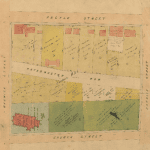The wider picture: history and background of suburbs, towns, and districts
Exploring the history of your building’s locality will help you understand how your house fits into the wider picture.
See our guide to Maps & plans for early street names, structures and landmarks, for example the 1841-1846 maps compiled by James Sprent including street names, landholders and building outlines, and these two maps of Hobart Town around 1860, Map of Hobart Town showing streets, waterways, public buildings and cemeteries (R. Jarman) and Hobart Town map and street directory showing businesses and significant buildings (F. Proeschel).
Tasmanian Archives: AF393/1/58
Also see the guide to Place names and publications on geographical names in our library collection.
Search for local histories published for many parts of Tasmania. For the best results, simply type ‘history’ and the locality you’re interested in into the search box for the library catalogue, and refine results on the left hand side of the page, for example by formats such as ‘books’ or ‘online’. Heritage reviews in our collection also shed light on aspects and themes that help to understand the area and its historic physical fabric.
Accounts from people living in Tasmania in periods such as the 1830s can be useful, especially if they have good indexes. For example Henry Button’s Flotsam and jetsam, floating fragments of life in England and Tasmania: an autobiographical sketch, with an outline of the introduction of responsible government : Launceston, Tas. : A.W. Birchall, 1909 (London : Hazell, Watson and Viney).
Examples of other detailed local history publications in our collection:
- Donald Howatson, Street by street publications for central Hobart and 7 suburbs: [New Town, Tasmania] : Donald Howatson, 2011 – 2016.
- John and Don Morris, History in our streets: the origins of Launceston street names: [Launceston, Tasmania] : Launceston Historical Society, 2013.
- Historic New Norfolk series : New Norfolk, Tas. : Historical and Information Centre, Derwent Valley Council, 1996.
- Frank L. Rigney, A midlands odyssey : a journey through parts of the northern midlands of Tasmania : Launceston, Tas. : F.L. Rigney, 2008
- William Graham Robertson, Hobart streets: [Hobart] : William Graham Robertson, 1919. This digitised handwritten guide provides rich detail on early 19th century Hobart streets and structures.

- Walch’s Tasmanian Almanac (also known as ‘the red book’) includes detailed annual information about Tasmania, including all regions and towns. The years 1870-1979/80 are available in the Hobart Reading Room, and 1863-1904 is available online via Ancestry Library Edition (access is onsite in our libraries only).
This selection of resources from the Launceston Local Studies Collection has a focus on northern Tasmania.
